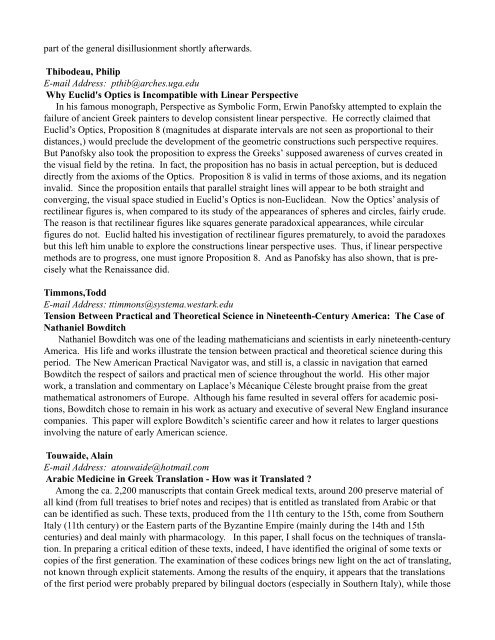Listing of Sessions and Abstracts of Papers - History of Science ...
Listing of Sessions and Abstracts of Papers - History of Science ...
Listing of Sessions and Abstracts of Papers - History of Science ...
Create successful ePaper yourself
Turn your PDF publications into a flip-book with our unique Google optimized e-Paper software.
part <strong>of</strong> the general disillusionment shortly afterwards.<br />
Thibodeau, Philip<br />
E-mail Address: pthib@arches.uga.edu<br />
Why Euclid's Optics is Incompatible with Linear Perspective<br />
In his famous monograph, Perspective as Symbolic Form, Erwin Pan<strong>of</strong>sky attempted to explain the<br />
failure <strong>of</strong> ancient Greek painters to develop consistent linear perspective. He correctly claimed that<br />
Euclid’s Optics, Proposition 8 (magnitudes at disparate intervals are not seen as proportional to their<br />
distances‚) would preclude the development <strong>of</strong> the geometric constructions such perspective requires.<br />
But Pan<strong>of</strong>sky also took the proposition to express the Greeks’ supposed awareness <strong>of</strong> curves created in<br />
the visual field by the retina. In fact, the proposition has no basis in actual perception, but is deduced<br />
directly from the axioms <strong>of</strong> the Optics. Proposition 8 is valid in terms <strong>of</strong> those axioms, <strong>and</strong> its negation<br />
invalid. Since the proposition entails that parallel straight lines will appear to be both straight <strong>and</strong><br />
converging, the visual space studied in Euclid’s Optics is non-Euclidean. Now the Optics’ analysis <strong>of</strong><br />
rectilinear figures is, when compared to its study <strong>of</strong> the appearances <strong>of</strong> spheres <strong>and</strong> circles, fairly crude.<br />
The reason is that rectilinear figures like squares generate paradoxical appearances, while circular<br />
figures do not. Euclid halted his investigation <strong>of</strong> rectilinear figures prematurely, to avoid the paradoxes<br />
but this left him unable to explore the constructions linear perspective uses. Thus, if linear perspective<br />
methods are to progress, one must ignore Proposition 8. And as Pan<strong>of</strong>sky has also shown, that is precisely<br />
what the Renaissance did.<br />
Timmons,Todd<br />
E-mail Address: ttimmons@systema.westark.edu<br />
Tension Between Practical <strong>and</strong> Theoretical <strong>Science</strong> in Nineteenth-Century America: The Case <strong>of</strong><br />
Nathaniel Bowditch<br />
Nathaniel Bowditch was one <strong>of</strong> the leading mathematicians <strong>and</strong> scientists in early nineteenth-century<br />
America. His life <strong>and</strong> works illustrate the tension between practical <strong>and</strong> theoretical science during this<br />
period. The New American Practical Navigator was, <strong>and</strong> still is, a classic in navigation that earned<br />
Bowditch the respect <strong>of</strong> sailors <strong>and</strong> practical men <strong>of</strong> science throughout the world. His other major<br />
work, a translation <strong>and</strong> commentary on Laplace’s Mécanique Céleste brought praise from the great<br />
mathematical astronomers <strong>of</strong> Europe. Although his fame resulted in several <strong>of</strong>fers for academic positions,<br />
Bowditch chose to remain in his work as actuary <strong>and</strong> executive <strong>of</strong> several New Engl<strong>and</strong> insurance<br />
companies. This paper will explore Bowditch’s scientific career <strong>and</strong> how it relates to larger questions<br />
involving the nature <strong>of</strong> early American science.<br />
Touwaide, Alain<br />
E-mail Address: atouwaide@hotmail.com<br />
Arabic Medicine in Greek Translation - How was it Translated ?<br />
Among the ca. 2,200 manuscripts that contain Greek medical texts, around 200 preserve material <strong>of</strong><br />
all kind (from full treatises to brief notes <strong>and</strong> recipes) that is entitled as translated from Arabic or that<br />
can be identified as such. These texts, produced from the 11th century to the 15th, come from Southern<br />
Italy (11th century) or the Eastern parts <strong>of</strong> the Byzantine Empire (mainly during the 14th <strong>and</strong> 15th<br />
centuries) <strong>and</strong> deal mainly with pharmacology. In this paper, I shall focus on the techniques <strong>of</strong> translation.<br />
In preparing a critical edition <strong>of</strong> these texts, indeed, I have identified the original <strong>of</strong> some texts or<br />
copies <strong>of</strong> the first generation. The examination <strong>of</strong> these codices brings new light on the act <strong>of</strong> translating,<br />
not known through explicit statements. Among the results <strong>of</strong> the enquiry, it appears that the translations<br />
<strong>of</strong> the first period were probably prepared by bilingual doctors (especially in Southern Italy), while those
















